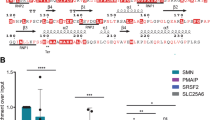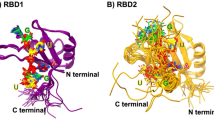Abstract
Hu proteins bind to adenosine-uridine (AU)-rich elements (AREs) in the 3′ untranslated regions of many short-lived mRNAs, thereby stabilizing them. Here we report the crystal structures of the first two RNA recognition motif (RRM) domains of the HuD protein in complex with an 11-nucleotide fragment of a class I ARE (the c-fos ARE; to 1.8 Å), and with an 11-nucleotide fragment of a class II ARE (the tumor necrosis factor α ARE; to 2.3 Å). These structures reveal a consensus RNA recognition sequence that suggests a preference for pyrimidine-rich sequences and a requirement for a central uracil residue in the clustered AUUUA repeats found in class II AREs. Comparison to structures of other RRM domain–nucleic acid complexes reveals two base recognition pockets in all the structures that interact with bases using residues in conserved ribonucleoprotein motifs and at the C-terminal ends of RRM domains. Different conformations of nucleic acid can be bound by RRM domains by using different combinations of base recognition pockets and multiple RRM domains.
This is a preview of subscription content, access via your institution
Access options
Subscribe to this journal
Receive 12 print issues and online access
$189.00 per year
only $15.75 per issue
Buy this article
- Purchase on Springer Link
- Instant access to full article PDF
Prices may be subject to local taxes which are calculated during checkout




Similar content being viewed by others
References
Chen, C.Y. & Shyu, A.B. Trends Biochem. Sci. 20, 465–470 (1995).
Keene, J.D. Proc. Natl Acad. Sci. USA 96, 5–7 (1999).
Antic, D., Lu, N. & Keene, J.D. Genes Dev. 13, 449–461 (1999).
Chung, S., Jiang, L., Cheng, S. & Furneaux, H. J. Biol. Chem. 271, 11518–11524 (1996).
Abe, R., Sakashita, E., Yamamoto, K. & Sakamoto, H. Nucleic Acids Res. 24, 4895–4901 (1996).
Ma, W.J., Chung, S. & Furneaux, H. Nucleic Acids Res. 25, 3564–3569 (1997).
Fan, X.C. & Steitz, J.A. EMBO J. 17, 3448–3460 (1998).
Levine, T.D., Gao, F., King, P.H., Andrews, L.G. & Keene, J.D. Mol. Cell Biol. 13, 3494–3504 (1993).
Park, S., Myszka, D.G., Yu, M., Littler, S.J. & Laird-Offringa, I.A. Mol. Cell Biol. 20, 4765–4772 (2000).
Gao, F.B., Carson, C.C., Levine, T. & Keene, J.D. Proc. Natl Acad. Sci. USA 91, 11207–11211 (1994).
Handa, N. . et al. Nature 398, 579–585 (1999).
Koushika, S.P., Lisbin, M.J. & White, K. Curr. Biol. 6, 1634–1641 (1996).
Koushika, S.P., Soller, M. & White, K. Mol. Cell Biol. 20, 1836–1845 (2000).
Bell, L.R., Maine, E.M., Schedl, P. & Cline, T.W. Cell 55, 1037–1046 (1988).
Jain, R.G., Andrews, L.G., McGowan, K.M., Pekala, P.H. & Keene, J.D. Mol. Cell Biol. 17, 954–962 (1997).
Bashaw, G.J. & Baker, B.S. Cell 89, 789–798 (1997).
Kelley, R.L., Wang, J., Bell, L. & Kuroda, M.I. Nature 387, 195–199 (1997).
Gebauer, F., Merendino, L., Hentze, M.W. & Valcarcel, J. RNA 4, 142–150 (1998).
Deo, R.C., Bonanno, J.B., Sonenberg, N. & Burley, S.K. Cell 98, 835–845 (1999).
Ding, J. . et al. Genes Dev. 13, 1102–1115 (1999).
Oubridge, C., Ito, N., Evans, P.R., Teo, C.H. & Nagai, K. Nature 372, 432–438 (1994).
Price, S.R., Evans, P.R. & Nagai, K. Nature 394, 645–660 (1998).
Varani, L. . et al. Nature Struct. Biol. 7, 329–335 (2000).
Antson, A.A. Curr. Opin. Struct. Biol. 10, 87–94 (2000).
Otwinowski, Z. & Minor, V. Methods Enzymol. 276, 307–326 (1997).
Matthews, B.W. J. Mol. Biol. 33, 491–497 (1968).
Navaza, J. Acta Crystallogr. A 50, 157–163 (1994).
Jones, T.A., Zou, J.Y., Cowan, S.W. & Kjeldgaard, M. Acta Crystallogr. A 47, 110–119 (1991).
Brünger, A.T., et al. Acta Crystallogr. D 54, 905–921 (1998).
Laskowski, R.A., MacArthur, M.W., Moss, D.S. & Thornton, J.M. J. Appl. Crystallogr. 26, 283–291 (1993).
Kraulis, P.J. J. Appl. Crystallogr. 24, 946–950 (1991).
Merritt, E.A. & Bacon, D.J. Methods Enzymol. 277, 505–524 (1997).
Kabsch, W. & Sander, C. Biopolymers 22, 1–17 (1983).
Barton, G.J. Protein Eng. 6, 37–40 (1994).
Acknowledgements
We thank G. Spizz for generously providing the human fetal brain cDNA; S. Strachan for initial cloning of expression constructs; W. Lai for performing preliminary RNA binding experiments; T. Transue for suggestions on RNA oligonucleotide design; C. Matson for assistance with crystallization; L. Pedersen, Z. Dauter and the staff of X9-B for assistance with data collection; J. Krahn for computer support and advice on crystallography; and P. Blackshear, D. Leahy, and K. Weeks for critical comments on this manuscript.
Author information
Authors and Affiliations
Corresponding author
Rights and permissions
About this article
Cite this article
Wang, X., Tanaka Hall, T. Structural basis for recognition of AU-rich element RNA by the HuD protein. Nat Struct Mol Biol 8, 141–145 (2001). https://doi.org/10.1038/84131
Received:
Accepted:
Issue Date:
DOI: https://doi.org/10.1038/84131
This article is cited by
-
The RNA binding proteins TIA1 and TIAL1 promote Mcl1 mRNA translation to protect germinal center responses from apoptosis
Cellular & Molecular Immunology (2023)
-
The solution structure of Dead End bound to AU-rich RNA reveals an unusual mode of tandem RRM-RNA recognition required for mRNA regulation
Nature Communications (2022)
-
Exploration of ligand binding modes towards the identification of compounds targeting HuR: a combined STD-NMR and Molecular Modelling approach
Scientific Reports (2018)
-
Molecular basis for the specific and multivariant recognitions of RNA substrates by human hnRNP A2/B1
Nature Communications (2018)
-
DND1 maintains germline stem cells via recruitment of the CCR4–NOT complex to target mRNAs
Nature (2017)



